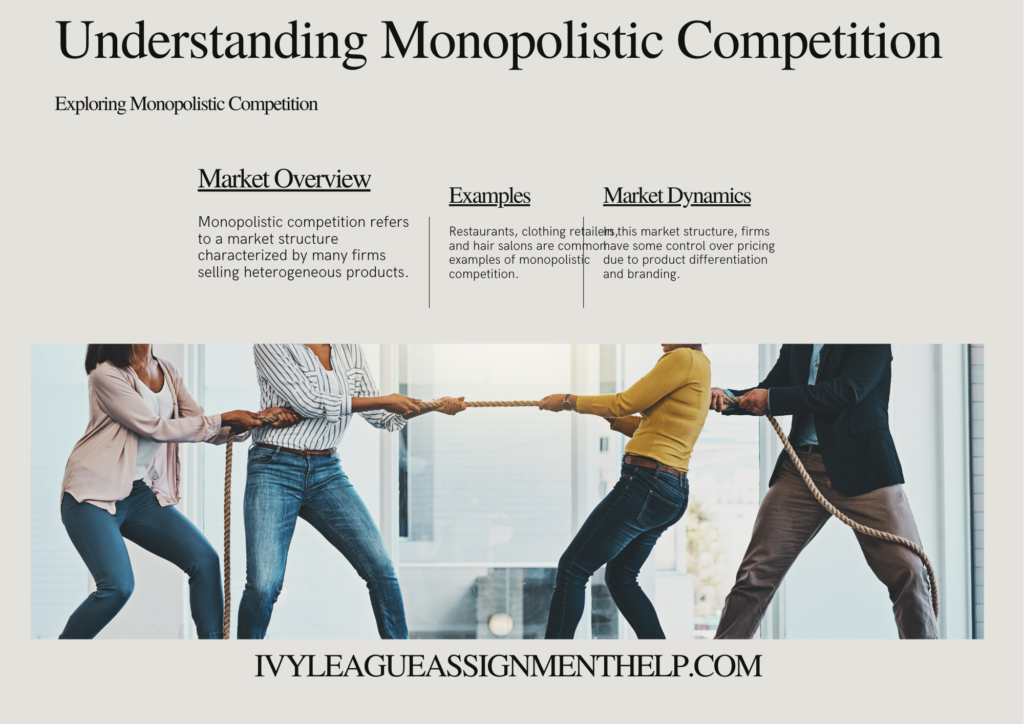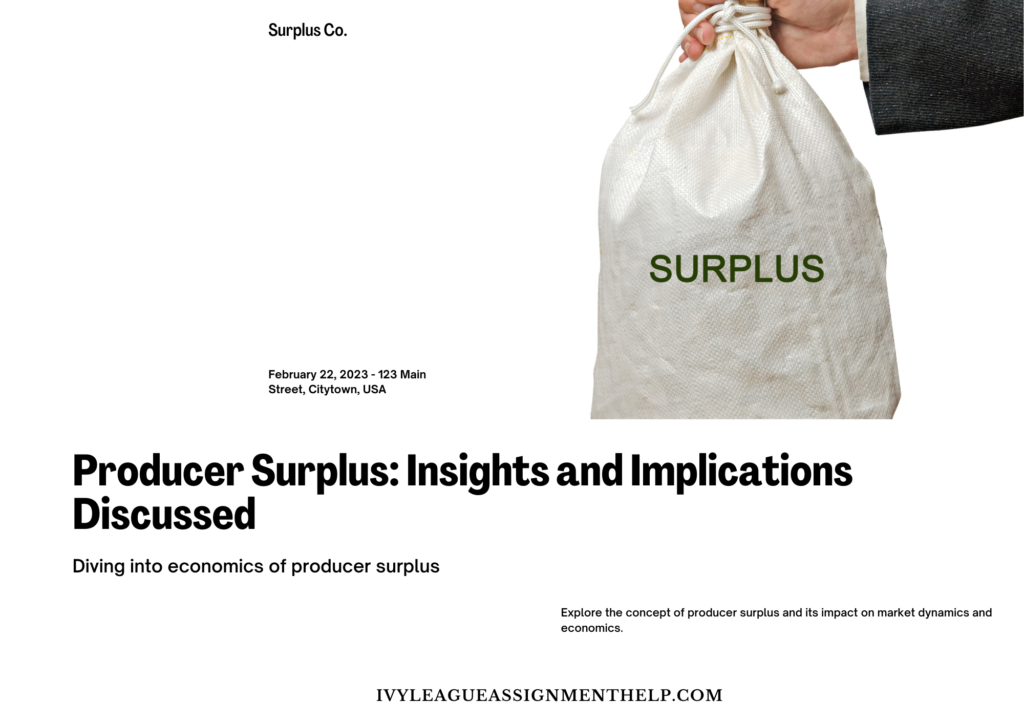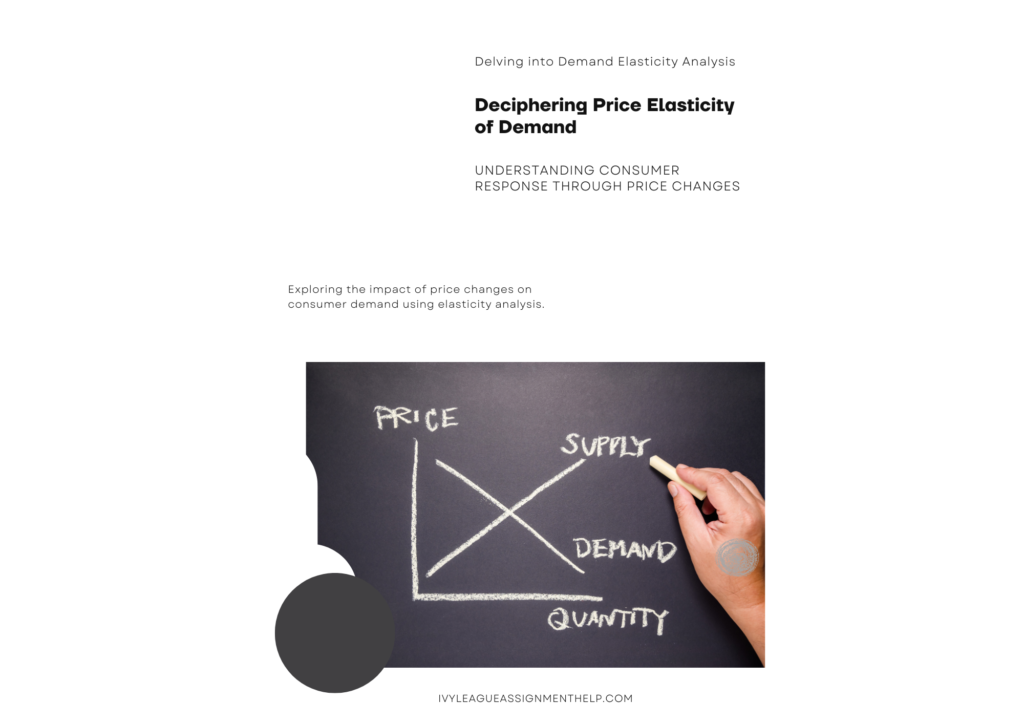Key Takeaways
- Monopolistic Competition Defined: A market structure with many firms offering differentiated products.
- Characteristics: Features include product differentiation, many sellers, and low barriers to entry.
- Real-World Examples: Common in industries like restaurants, clothing, and consumer goods.
- Pricing and Competition: The role of branding, advertising, and non-price competition.
- Consumer Impact: Benefits and drawbacks of monopolistic competition for consumers.
- Regulation and Policy: How governments regulate to maintain fair competition and protect consumers.
Introduction to Monopolistic Competition
Monopolistic competition is a market structure characterized by many firms offering products that are similar but not identical. This structure combines elements of both monopoly and perfect competition, leading to unique market dynamics. At ivyleagueassignmenthelp.com we help and guide students to understand how monopolistic competition is essential for analyzing how businesses operate and compete, particularly in consumer-focused industries.

Characteristics of Monopolistic Competition
Product Differentiation
In monopolistic competition, firms differentiate their products through branding, quality, features, and customer service. This differentiation creates a perceived uniqueness, allowing firms to charge higher prices than in perfect competition.
Many Sellers
The market consists of many sellers, each with a relatively small market share. This prevents any single firm from having significant control over the market, promoting competition.
Low Barriers to Entry
Low barriers to entry encourage new firms to enter the market, maintaining competition. This contrasts with monopolies and oligopolies, where high barriers restrict entry.
Non-Price Competition
Firms compete more on product quality, features, and advertising rather than price. Non-price competition helps firms build brand loyalty and differentiate themselves from competitors.
Examples of Monopolistic Competition
Restaurant Industry
The restaurant industry exemplifies monopolistic competition, with numerous establishments offering diverse menus, dining experiences, and price points. Each restaurant strives to stand out through unique dishes, ambiance, and service quality.
Clothing and Apparel
In the clothing industry, brands differentiate themselves through style, quality, and brand image. Consumers have a wide range of choices, from luxury brands to affordable fashion, each with its unique appeal.
Consumer Goods
The market for consumer goods, such as electronics, cosmetics, and household items, also reflects monopolistic competition. Companies invest heavily in product innovation, advertising, and customer service to gain a competitive edge.
Product Differentiation Strategies
Branding
Effective branding creates a strong identity for products, making them recognizable and preferred by consumers. Branding involves logos, slogans, packaging, and consistent quality.
Quality and Features
Offering superior quality or unique features can set a product apart from competitors. Innovations in technology, design, and functionality play a critical role in differentiation.
Customer Service
Providing exceptional customer service enhances brand loyalty and customer satisfaction. Firms invest in training, support systems, and after-sales services to differentiate their offerings.
| Product Differentiation Strategies | Examples |
|---|---|
| Branding | Nike, Coca-Cola, Apple |
| Quality and Features | Dyson, Tesla, Sony |
| Customer Service | Amazon, Zappos, Nordstrom |
Pricing in Monopolistic Competition
Price Flexibility
Firms in monopolistic competition have some control over pricing due to product differentiation. While prices are influenced by market demand, firms can charge a premium for unique features or brand value.
Demand Elasticity
The demand for products in monopolistic competition is relatively elastic because consumers have many alternatives. Firms must balance pricing with perceived value to attract and retain customers.
Impact of Advertising
Advertising plays a crucial role in shaping consumer perceptions and demand. Effective advertising can create brand awareness, highlight unique features, and justify higher prices.
Non-Price Competition
Importance of Advertising
Advertising is vital for creating brand recognition and loyalty. Firms use various advertising channels, including TV, social media, and print media, to reach their target audience.
Role of Branding
Strong branding differentiates products and builds customer loyalty. Brands invest in consistent messaging, quality assurance, and customer engagement to maintain their market position.
Enhancing Product Quality
Continuous improvement in product quality is essential for staying competitive. Innovations, customer feedback, and quality control processes help firms enhance their products.
Short-Run and Long-Run Equilibrium
Short-Run Profitability
In the short run, firms in monopolistic competition can earn economic profits due to product differentiation and brand loyalty. However, these profits attract new entrants, increasing competition.
Long-Run Normal Profits
In the long run, the entry of new firms erodes economic profits, leading to normal profits. Firms continue to invest in differentiation and innovation to maintain their market share.
Economic Efficiency
Monopolistic competition is less economically efficient than perfect competition due to higher prices and excess capacity. However, it offers benefits like product variety and innovation.
| Short-Run vs. Long-Run in Monopolistic Competition | Short-Run | Long-Run |
|---|---|---|
| Profitability | Economic Profits | Normal Profits |
| Number of Firms | Stable or Increasing | Increasing |
| Market Entry | Attracts New Entrants | Continues until Profits Normalize |
| Product Differentiation | High | Maintained through Innovation |
Comparison with Other Market Structures
Perfect Competition
Unlike perfect competition, where products are homogeneous and firms are price takers, monopolistic competition involves differentiated products and some price-setting power.
Monopoly
Monopolies have a single seller with significant control over prices and barriers to entry, contrasting with the many sellers and low barriers in monopolistic competition.
Oligopoly
Oligopolies consist of a few dominant firms with substantial market power and higher barriers to entry, while monopolistic competition features many firms and low entry barriers.
Consumer Impact
Advantages
- Product Variety: Consumers benefit from a wide range of choices due to product differentiation.
- Innovation: Competitive pressure drives firms to innovate, improving product quality and features.
- Brand Loyalty: Strong branding and customer service enhance consumer satisfaction and loyalty.
Disadvantages
- Higher Prices: Differentiation and branding can lead to higher prices compared to perfect competition.
- Advertising Costs: High spending on advertising and branding can increase product prices.
- Inefficiency: The market may experience excess capacity and inefficiencies compared to perfect competition.
Regulation and Policy
Government Role
Governments regulate monopolistic competition to ensure fair practices, protect consumers, and maintain competitive markets. Policies may include consumer protection laws and advertising standards.
Antitrust Laws
Antitrust laws prevent anti-competitive practices, such as collusion and monopolization. These laws aim to promote competition and prevent market dominance by a few firms.
Ensuring Fair Competition
Regulatory bodies monitor market behavior, investigate complaints, and enforce regulations to ensure fair competition and protect consumer interests.
Global Perspectives
International Examples
Monopolistic competition is prevalent worldwide in various industries, including retail, hospitality, and consumer electronics. Each market adapts to local consumer preferences and regulatory environments.
Global Market Dynamics
Globalization and technological advancements have increased competition in monopolistic markets. Firms must adapt to changing consumer demands, technological innovations, and international competitors.
Future Trends in Monopolistic Competition
Technological Advancements
Advancements in technology continue to shape monopolistic competition, driving innovation and changing competitive dynamics. Firms must invest in technology to stay competitive.
Market Evolution
The evolution of consumer preferences, regulatory changes, and market disruptions influence the future of monopolistic competition. Firms need to remain agile and responsive to these changes.
FAQs
What is monopolistic competition?
Monopolistic competition is a market structure where many firms offer differentiated products, allowing for some degree of price-setting power and extensive non-price competition.
How do firms differentiate their products in monopolistic competition?
Firms differentiate their products through branding, quality, features, and customer service, creating perceived uniqueness and building brand loyalty.
What are the advantages of monopolistic competition for consumers?
Consumers benefit from product variety, innovation, and enhanced customer service due to the competitive nature of monopolistic markets.
What are the disadvantages of monopolistic competition for consumers?
Disadvantages include higher prices due to differentiation and advertising costs, and potential inefficiencies compared to perfect competition.
How do governments regulate monopolistic competition?
Governments regulate monopolistic competition through consumer protection laws, advertising standards, and antitrust laws to ensure fair competition and protect consumers.
What are some examples of monopolistic competition in the real world?
Examples include the restaurant industry, clothing and apparel markets, and consumer goods sectors, where numerous firms offer differentiated products.


